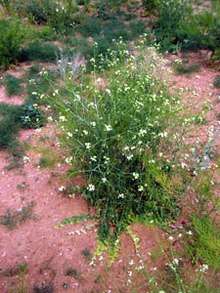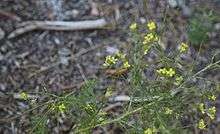Sisymbrium altissimum
Sisymbrium altissimum is a species of Sisymbrium. The plant is native to the western part of the Mediterranean Basin in Europe and Northern Africa and is widely naturalized throughout most of the world, including all of North America.[1] It was probably introduced into North America by a contaminant crop seed. The plant grows in soils of all textures, even sand. The plant germinates in winter or early spring. The blooming time is lengthy, and after maturity the plant forms a tumbleweed. Common names of the plant include Jim Hill mustard, after James J. Hill, a Canadian-American railroad magnate,[2] tall tumblemustard,[3] tall mustard, tumble mustard,[4] tumbleweed mustard, tall sisymbrium, and tall hedge mustard.[1]
| Sisymbrium altissimum | |
|---|---|
 | |
| Scientific classification | |
| Kingdom: | Plantae |
| Clade: | Tracheophytes |
| Clade: | Angiosperms |
| Clade: | Eudicots |
| Clade: | Rosids |
| Order: | Brassicales |
| Family: | Brassicaceae |
| Genus: | Sisymbrium |
| Species: | S. altissimum |
| Binomial name | |
| Sisymbrium altissimum | |


Description
Tumble mustard forms a tall (up to 5 ft) but delicate-looking plant, with slender, much-branched stems. Its stem leaves are divided into thin, linear lobes, while the basal leaves are broader and pinnately compound. The flowers are inconspicuous and only 1/4 inch wide. They have four usually yellow petals and four narrow, curved sepals. The seedpods are slender and long (2-4 inches). At maturity it dies, uproots, and tumbles in the wind, spreading its seeds.[5]
References
- Royer, France; Richard Dickinson (1999). Weeds of the Northern U.S. and Canada: A Guide for Identification. The University of Alberta Press. p. 470. ISBN 978-1-55105-221-2.
- Hall, Joan Houston; Cassidy, Frederic G., eds. (1996). Dictionary of American Regional English, Volume III, I-O. Belknap Press. pp. 960. ISBN 978-0-674-20519-2.
- "Sisymbrium altissimum". Natural Resources Conservation Service PLANTS Database. USDA. Retrieved 16 November 2015.
- Johnson, Edited by Eileen (1987). Lubbock Lake : late quaternary studies on the southern high plains. College Station: Texas A&M University Press. p. 29. ISBN 0-89096-321-5.CS1 maint: extra text: authors list (link)
- Laird R. Blackwell (2002). Wildflowers of the Eastern Sierra and adjoining Mojave Desert and Great Basin. Lone Pine Publishing. ISBN 978-1-55105-281-6.